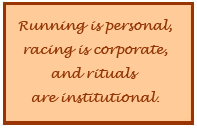It is easy to think of elite athletes as superheroes. If it wasn't because the practice of the sport requires certain attire for comfort and speed, elite athletes would wear a red cape Superman style as they move gracefully through the wind, while keeping their 4-minute mile running pace (not the rest of the suit, though - it was never cool to wear underwear over your pants). Superheroes and athletes also have a certain presence; there is a feeling of awe, if you will, from those of us watching as he takes a child to safety from a burning building, or she crosses the finish line to beat her own world record by five seconds.
So when I met Hernan Rubiano for the first time, I noticed he wasn't wearing a cape. In fact, he was wearing a t-shirt, shorts and sneakers, just like many of us mere mortals wear in hot August afternoons in Southern California. He looked buffed under the loose-fitting shirt, but he was shorter and more slender than I expected for an elite athlete (or a superhero). “Ernie”, as his training teammates called him in the U.S., is calm, good-natured, and unpretentious. He laughs a lot and is shy, the way Clark Kent is shy, blushes and hides behind his large frame glasses.
I spent some time with Ernie during his brief breaks from training with tri-athletes from all over the world. He has participated in numerous triathlon competitions throughout Latin America and in the U.S. Ernie shared some of his experiences on and off the course, as well as some of his thoughts on life during an informal interview, conducted shortly after a 6-mile run at my pace during which Ernie didn’t even break a sweat. Below are abridged excerpts from the first piece of this three-part article.
Athlete Profile
In 2009, Hernan Rubiano won a gold medal in the triathlon Olympic distance category and a silver medal in the sprint distance category at the Bolivarian Games held in Bolivia. He placed second in the South American triathlon championship held near Medellin, Colombia. He placed 9th in the elite category in the Malibu, California triathlon in September. U.S. Olympic team male and female athletes participated in the Malibu event. And he won first place in the Playa del Rey, California sprint triathlon.
Jairo Ospina: How did you get to be a tri-athlete? How did it all start?
Hernan Rubiano: Since my childhood, my mother made sure my brother and I were physically active, which I think instilled discipline in us. I started with swimming lessons, and after a short time, I met a coach that helped me get better at swimming in my high school years. My swimming coach also practiced mountain biking, so he got me interested and I practiced that sport for about two years. During a rescue swimming course, I met and then joined a group of college-level tri-athletes. When they stopped training as a group, I joined a club of experienced tri-athletes shortly thereafter and never left the sport. That was 8 years ago.
JO: How do you compare the competitive level of Latin-American athletes to the American or European athletes?
HR: It is more difficult to practice in Latin America, in part because sponsorship for the sport is less solid and not as stable as it is for other sports. There are great athletes, worthy of competing at an international level, but there are less fans. Triathlon is simply more popular in the U.S. and Europe.







 Metaphors have the power to transform the mundane and trivial into the immortalized and spiritual. Having said that, it suddenly becomes clear how religion have used metaphors to exemplify and make sense, to expand and assure, to distinguish and grow faith. Metaphors, however, do not have any effect to the hearers unless they are able to connect with them in the intimate level. Only when we immerse ourselves in the explicit that is at hands, we are able to move into the implicit that is beyond. Then, and only then, we can fully embrace the faith hidden within each metaphor, catch the spirit within each allegory, and internalize the moral within each story.
Metaphors have the power to transform the mundane and trivial into the immortalized and spiritual. Having said that, it suddenly becomes clear how religion have used metaphors to exemplify and make sense, to expand and assure, to distinguish and grow faith. Metaphors, however, do not have any effect to the hearers unless they are able to connect with them in the intimate level. Only when we immerse ourselves in the explicit that is at hands, we are able to move into the implicit that is beyond. Then, and only then, we can fully embrace the faith hidden within each metaphor, catch the spirit within each allegory, and internalize the moral within each story.



